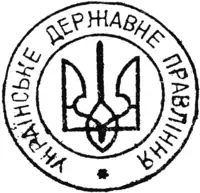Ukrainian national government (1941)
The Ukrainian national government[1] (Ukrainian: Українське Державне Правління (УДП), Ukrainske Derzhavne Pravlinnia (UDP); Ukrainian State Board) of 1941 was a self-proclaimed Ukrainian government established on the Ukrainian territories occupied by Nazi Germany. The government was established by the 30 June 1941 Act of restoration of the Ukrainian state. It was led by the Stepan Bandera's faction of OUN.
Ukrainian National Government Українське Державне Правління (УДП) Ukrainske Derzhavne Pravlinnia (UDP) | |||||||||
|---|---|---|---|---|---|---|---|---|---|
| 1941 | |||||||||
| Status | Unrecognized state | ||||||||
| Capital | Lviv | ||||||||
| Official languages | Ukrainian | ||||||||
| Prime Minister | |||||||||
• 1941 | Yaroslav Stetsko | ||||||||
| Historical era | World War II | ||||||||
• Declared | 30 June 1941 | ||||||||
• Disestablished | July 1941 | ||||||||
| |||||||||
| Today part of | |||||||||
Part of a series on the |
|---|
| History of Ukraine |
|
|
On 22 June 1941 leaders of the OUN met in Kraków, occupied Poland, and established a plan to create a Ukrainian state. The leaders of this meeting, Vsevolod Petriv and Volodymyr Horbovy, sent a letter to Adolf Hitler offering cooperation in exchange for Ukrainian independence.[2][3]
With the beginning of Operation Barbarossa, many thought that they found a new ally in Nazi Germany. The leader of the government was Yaroslav Stetsko. Many members were former government officials and military leaders of the Ukrainian People's Republic. Germany did not recognise the government; it arrested and imprisoned its members within a matter of weeks.
Government structure
The government of 1941 was an attempt to include as many political parties in Ukraine as possible. The structure and nomenclature of the government functionaries were quite extensive. They included:
The Prime Minister was Yaroslav Stetsko
- Deputy Prime Minister – Marian Panchyshyn – no political affiliation
- Deputy Prime Minister – Lev Rebet (OUN)
- Minister of the Interior – Volodymyr Lysy (Socialist Radical Party)
- Minister of External Affairs – Volodymyr Stakhiv
- Minister of Defence – Vsevolod Petriv (Social Revolution Party)
- Minister of State Security – Mykola Lebed (OUN)
- Minister of Justice – Yulian Fedusevych
- Minister of Agriculture – Yevhen Khraplyvy (Ukrainian National-Democratic Party)
- Minister of Health Marian Panchyshyn (no political affiliation)
- Minister of Education Volodymyr Radzykevych (no political affiliation)
- Minister of Communication N. Moroz (no political affiliation)
- Minister of Information Oleksandr Hai-Holovko (no political affiliation)
- Minister of Political Coordination Ivan Klymiv-Lehenda (OUN)
- Deputy Minister of Interior Konstantyn Pankivsky (Socialist Radical Party)
- Deputy Minister of External Affairs Oleksandr Maritchak (Ukrainian National-Democratic Party)
- Deputy Minister of Defense Roman Shukhevych (OUN)
- Deputy Minister of Defense Oleksandr Hasyn (OUN)
- Deputy Minister of Justice Bohdan Dzerovych (no political affiliation)
- Deputy Minister of Agriculture Andriy Piasetsky (Front of National Unity)
- Deputy Minister of Health Roman Osinchuk
- Secretary of the Ministry of Health Oleksandr Barvinsky (no political affiliation)
The government also featured a Council of Seniors, which was headed by Kost Levytsky.
References
- Magocsi, Robert Paul (2002). The Roots of Ukrainian Nationalism. University of Toronto Press. p. 33.
- http://www.encyclopediaofukraine.com/display.asp?AddButton=pages\U\K\UkrainianNationalCommitteeCracow.htm
- https://archive.org/stream/FraudFamineAndFascsim/tottlefraud_djvu.txt

